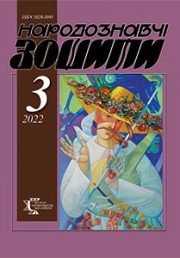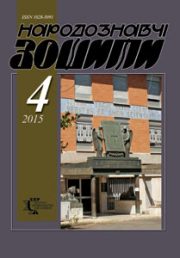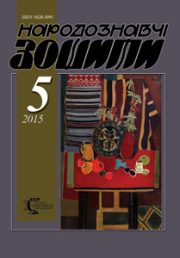The Ethnology Notebooks. 2018, 3 (141), 269–280
UDK 745.52.046(44)”16”:[069.02:39(477.83-25)
DOI https://doi.org/10.15407/nz2018.01.269
Received 4.02.2018
FRENCH ROYAL TRAIL OF ANCIENT LOVE IN LVIV TAPESTRIES
ORCID ID: https://orcid.org/0000-0002-8383-227X
Klimashevskyi Andrii, Candidate of Sciences in Art Studies,
Deputy in scientific and museum work of director
of the Institute of Ethnology
of the National Academy of Sciences of Ukraine.
Svobody Avenue 15, 79000, Lviv, Ukraine.
Contacts: e-mail: ina@mail.lviv.ua
Oksana Herii, Candidate of Sciences in Art Studies,
Senior Researcher,
Folk Art Department
of the Institute of Ethnology
of the National Academy of Sciences of Ukraine.
Svobody Avenue 15, 79000, Lviv, Ukraine.
Contacts: e-mail: ina@mail.lviv.ua
Abstract. The article attributes the tapestry of the XVII century, which is presented in the exposition of the Lviv Museum of Ethnography and Arts. The country of production of this tapestry, the manufactory, a probable author of the cardboard to it is ascertained on the basis of use of a broad comparative material, analysis of iconography, compositional construction, and disclosure of the symbolic and allegorical content of the images, the country of production of this tapestry. The plot action, presented in the mullion of the wallpaper, is considered and interpreted in the context of the cultural-historical and political processes in Europe XVII century.
Keywords: tapestry, wallpaper, baroque, France, Aubusson, Anna Austrian, Mazarini, Cleopatra, Simone Wue.
REFERENCES
Bokkardo, P. Di Fabio K. (2011). Muzei Strada Nuova. Genuja. Har’kov: Chajka.
Bol’shaja illjustrirovannaja jenciklopedija drevnosti. Praga: Artija, 1980.
Vlasov, V. (2004). Novyj jenciklopedicheskij slovar’ izobrazitel’nogo iskusstva: v 10 t. (T. 2). Sankt-Peterburg: Azbuka-Klassika.
Gandl, S. (2011). Glazur. Moskva: Novoe literaturnoe obozrenie.
Gonsales, M. Bartolena, S. (2011). Zhenshhiny. Moskva: Omega.
Dzhulio Mazarini (2003). Ot Renessansa do veka Prosveshhenija. Moskva: Art-Rodnik.
Impelluzo, L. (2007). Geroi i bogi antichnosti. Moskva: Omega.
Impelluzo, L. (2009). Priroda i ee simvoly. Moskva: Omega.
Kastria, F., Dzuffi, S. (2002). Zhivopis’ barokko. Glubiny dushi v bespredel’nosti mira. Moskva: Astrel’.
Kibalova, L., Verbenova, O., Lamarova, M. (1980). Illjustrirovannaja jenciklopedija mody. Praga: Artija.
Levi, Je. (2007). Kardinal Rishel’e i stanovlenie Francii. Moskva: Astrel’.
Onori, L.M., Barukka, G. (2012). Nacional’naja galereja Marke. Kiev: Novyj Druk.
Paskvinelli, B. (2009). Zhest i jekspressija. Moskva: Omega.
Rapelli, P. (2008). Simvoly vlasti i velikie dinastii. Moskva: Omega.
Sharnova, E. (2010). Luvr. Moskva: Slovo.
Shtajn, V. (2003). Hronologija mirovoj civilizacii (T. 1). Moskva: Slovo.
Brosens, К. (2001). Nouvelles données sur l’Histoire de Cléopâtre. Le réseau parent et la tapisserie bruxelloise à la française’. Revue belge d’archйologie et d’histoire de l’art. № 70. Р. 63–77.
Campbell, Т.Р., Bertrand P.F., Bapasola. (2007). Tapestry in the Baroque: Threads of Splendor. New York: Metropolitan Museum of Art.
Charles Poerson, 1609–1667. Сatalogue par Barbara Brejon de Lavergnйe, Nicole de Reyniиs, Nicolas Sainte Fare Garnot. Paris: Arthena, 1997.
Hartkamp-Jonxis, E. (2006). Scandinavische connectie. Nederlandse wandtapijten en andere tapisserieweefsels in relatie tot hun Deense en Zweedse afnemers, 1615 tot 1660. Textielhistoriche Bijdragen. № 46. P. 45–72.
Hartkamp-Jonxis, E., Smith, H. (2004). European Tapestries in the Rijksmuseum. Amsterdam.
Heinz, D. (1995). Europдische Tapisseriekunst des 17. und 18. Jahrhunderts. Wien.
Hennel-Bernasikowa, M. (2000). Gobeliny XV–XIX wieku w zamku krуlewskim na Wawelu. Zamek krуlewski na Wawelu. Krakуw.
Jervis, S. (1984). The Penguin Dictionary of Design and Designers. London.
Przymanowski, J. (1983). Odsiecz Europy. Warszawa: Nasza Ksiкgarnia.
Reyniès N. Decouverte d’une tenture française «L’histoire de Clèopâtre», XVII siècle. Cataloque. Nice: Palais Lascaris.
Reyniès N., Laveissiиre, S. (2005). Isaac Moillon 1614–1673. Un peintre du roi á Aubusson. Paris: Somogy.
Saule, B., Meyer, D. (1999). Versailles. Paris: Art Lys.
Thieme, U., Becker, F. (1933). Allgemeines Lexikon der bildenden Kьnstler. Vol. 27.
Antony Presents Artavasdes, King of the Armenians, to Cleopatra from The Story of Antony and Cleopatra: The Art Institute of Chicago. URL: http://www.artic.edu/aic/collections/artwork/90513.
Brosens, К., Delmarcel, G. (2005). Isaac Moillon, un peintre du roi à Aubusson: Some Reflections and Addenda. URL: http://www.studiesinwesterntapestry.net.
«La mort de Cléopâtre», pièce de la tenture de l’Histoire des amours de Marc. URL: http://www.musees-mediterranee.org/portail/collections_fiche.php?menu=6&num_coll2=1300.
Mailho-Daboussi, L. (2010). Les tapisseries: étude d’une collection publique. In Situ. № 13. 2010. URL: http://journals.openedition.org/insitu/6960.
Palais Lascaris. URL: http://tresors.nice.fr/lieu/palais-lascaris-nice.
The Battle of Actium from The Story of Caesar and Cleopatra: The Art Institute of Chicago. URL: http://www.artic.edu/aic/collections/exhibitions/ divineart/artwork/147056/print.






